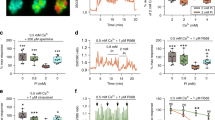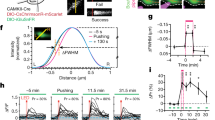Abstract
THE release of neurohypophyseal hormones, whether evoked by electrical stimulation or by a high potassium concentration, is associated with an uptake of calcium from the extracellular space1–4. It has therefore been proposed that calcium entry plays a key role in stimulus-secretion coupling in the neurohypophysis5–7. Recently, calcium ionophores have been described which increase calcium flux across the cell membrane and induce secretion in a number of secretory systems8–12. In contrast, we report that although the calcium ionophore X-537A (Lasalocid, Hofmann-LaRoche) promotes secretion from the rat neurohypophysis, there is no corresponding increase in calcium uptake; furthermore, ionophore-induced secretion persists in the absence of external calcium ions. The most logical explanation for these results is that, rather than increasing the influx of extra-cellular calcium, the ionophore actually releases calcium from intracellular binding sites, probably mitochondria; and that it is the mobilisation of this internal calcium which, inter alia, promotes secretion.
This is a preview of subscription content, access via your institution
Access options
Subscribe to this journal
Receive 51 print issues and online access
$199.00 per year
only $3.90 per issue
Buy this article
- Purchase on Springer Link
- Instant access to full article PDF
Prices may be subject to local taxes which are calculated during checkout
Similar content being viewed by others
References
Douglas, W. W., and Poisner, A. M., J. Physiol. Lond., 172, 19–30 (1964).
Mikiten, T. M., and Douglas, W. W., Nature, 207, 302 (1965).
Dreifuss, J. J., Grau, J. D., and Nordmann, J. J., J. Physiol. Lond., 231, 96–98P (1973).
Nordmann, J. J., thesis, Univ. Geneva, (1973).
Douglas, W. W., Br. J. Pharmac., 34, 451–474 (1968).
Rubin, R. P., Pharmac. Rev., 22, 389–428 (1970).
Matthews, E. K., in Calcium and Cellular Function (edit. by Cuthbert, A. W.), 163–182 (1970).
Reed, P. W., and Lardy, H. A., J. biol. Chem., 247, 6970–6977 (1972).
Levy, J. V., Cohen, J. A., and Inesi, G., Nature, 242, 461–463 (1973).
Foreman, J. C., Mongar, J. L., and Gomperts, B. D., Nature, 245, 249–251 (1973).
Feinman, R. D., and Detwiler, T. C., Nature, 249, 172 (1974).
Nakazato, Y., and Douglas, W. W., Nature, 249, 479–481 (1974).
Bisset, G. W., Clark, B. J., Haldar, J., Harris, M. C., Lewis, G. P., and Roche e Silva, M., Br. J. Pharmac., 31, 537–549 (1967).
Miledi, R., Proc. R. Soc., B 183, 421–425 (1973).
Barker, L. A., Dowdall, M. J., and Whittaker, V. P., Biochem. J., 130, 1063–1080 (1972).
Author information
Authors and Affiliations
Rights and permissions
About this article
Cite this article
NORDMANN, J., CURRELL, G. The mechanism of calcium ionophore-induced secretion from the rat neurohypophysis. Nature 253, 646–647 (1975). https://doi.org/10.1038/253646a0
Received:
Revised:
Published:
Issue Date:
DOI: https://doi.org/10.1038/253646a0
This article is cited by
-
Effects of divalent cation ionophores on the neuron membrane of the crayfish
The Journal of Membrane Biology (1979)
-
Effect of calcium ionophore Br-X537A on renin synthesis and release in Amphiuma means kidney culture
Nature (1978)
-
Activation of gastro-intestinal smooth muscle induced by the calcium ionophore A23187
Pfl�gers Archiv European Journal of Physiology (1977)
-
Release of noradrenaline by the ionophore X537A from normal and reserpinized guinea-pig atrium
Naunyn-Schmiedeberg's Archives of Pharmacology (1977)
-
New calcium-mobilising agent
Nature (1975)
Comments
By submitting a comment you agree to abide by our Terms and Community Guidelines. If you find something abusive or that does not comply with our terms or guidelines please flag it as inappropriate.



